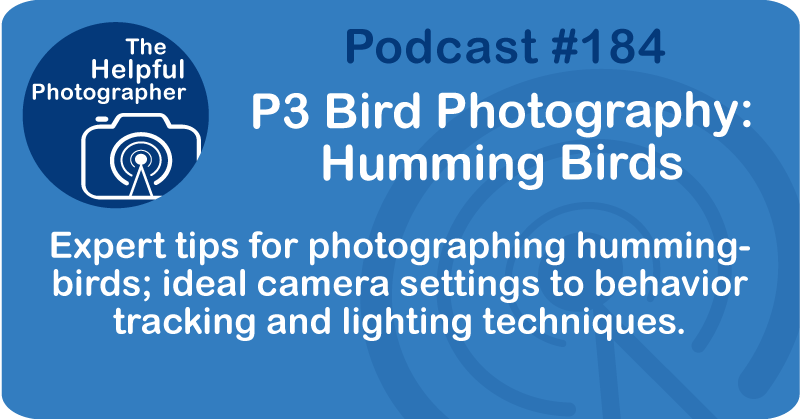P3 Bird Photography: Hummingbirds #184

This is part three of a six-part series on bird photography. In the last couple of episodes, we talked about why shutter priority with auto ISO is the best way to go for birds in flight. And then in episode 183, I shared how I use custom settings to keep my ISO under control while still being ready for sudden action. Today, we're going to take all of that and apply it to one of the most challenging—and honestly most rewarding—subjects out there: hummingbirds.
These guys are like little rockets with feathers. They're unpredictable, territorial, and they rarely sit still. Photographing them can be frustrating, but when you nail it—man, it's an amazing feeling.
So first things first—like all wildlife—the name of the game is understanding behavior. The more you observe, the more predictable they become, and the more likely you'll get a great shot.
With hummingbirds, if you're photographing them around feeders, life gets a little bit easier. In a field of flowers, it's trickier. They'll dart from bloom to bloom, usually only stopping for just a couple of seconds because each flower doesn't offer much nectar. If you decide to go with the flower route, you're going to have to find a busy spot, settle in, and just watch for a while. You're going to have to learn their flight paths and figure out where they tend to hover. That's when and where you'll get your chance.
Now, feeders—a lot of people have mixed feelings about them. Some conservationists don't love them because they can encourage dependence or spread disease if they're not cleaned properly. They say that feeders make the hummingbirds fat and lethargic. But I think that makes things a little bit easier for us photographers.
Okay, but here's the thing: if you do capitalize on a feeder, you really don't want the feeder in the shot, right? What I observed is that they like to zip in, take a quick drink, and then back off and hover. And that's your moment. A clean shot, no feeder in the frame, and the bird doing what they do best—flying. So feeders can be really helpful, but again, it's a timing thing. You really do need to watch how they behave.
Once you've nailed your clean, classic hummingbird shot, start thinking creatively. Play with light. One of my favorite approaches is backlighting. If you can position yourself so the bird is between you and the sun, the light just pours through their wings. You can end up with these amazing, beautiful glowing silhouettes—almost like stained glass.
And here's something else to keep an eye on: hummingbirds are extremely territorial. You'll see little aerial battles break out all the time. They'll chase each other, dive bomb, and sometimes even collide in midair. Those interactions are gold for photographers. So start thinking outside the box—not just a bird on a stick.
So what about settings? I said in the last episode, I like to shoot in shutter priority and in auto ISO. If you want sharp wings—and trust me, those wings move crazy fast—you'll need a shutter speed of at least 1/4000th of a second and sometimes even faster.
Some photographers have suggested going slower, like 1/1000th or 1/500th of a second, to capture motion blur in the wings. I think it can work, but honestly, in my experience, most of the time the wings just disappear or look like awkward smears. It's not that painterly motion blur that we all imagine. It often looks like the bird lost its wings. So experiment, try different speeds, and see what works for you.
I personally find 1/4000th gives me the best balance—sharp wings, sharp body, and a really clean look. For me, even 1/3200th of a second can start to feel a little soft.
Quick Recap:
- Study their behavior.
- Anticipate flight paths and hover spots.
- Use feeders smartly, but aim for clean shots when they back off.
- Watch for interactions like aerial fights.
- Play with light—especially backlighting—for glowing wings.
All right, that's hummingbirds in a nutshell. Challenging, but incredibly rewarding once you start to anticipate their moves. In the next episode, we'll zoom out from settings and focus on routines.











